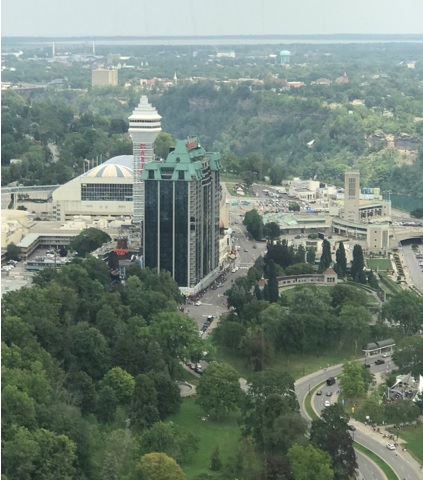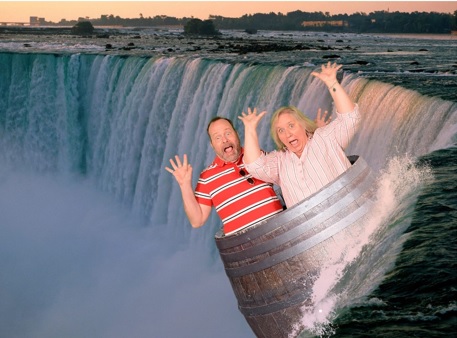By Michael Pearsall, P.Eng., CVS, FEC – President, SAVE International
Recently, I had the opportunity to enjoy an anniversary lunch with my wife overlooking Niagara Falls. We are fortunate that we don’t live very far from this natural wonder; however, we often take it for granted and don’t stop to enjoy it unless we have visitors. Thankfully, every so often we “play tourist” and take some time to enjoy the things that originally drew us to move our family here. This day we decided to have a special lunch at the Skylon Tower rotating restaurant for a great view.

While enjoying the view, I spotted the location of our 2016 Value Summit and was reminded of its theme: The Power of Value Engineering. This theme was based on the famous horseshoe falls on the border between the United States and Canada.
Why did we choose this theme? Why was I compelled to tell you this again? I think we sometimes take the methodology, and all we know about it, for granted. Take a trip with me to “play tourist” and consider some symbolism to help share the methodology with others.
The average flow of water over the main portion of Niagara Falls is about 2000 cubic meters per second. However, it can peak to nearly 3000 cubic meters per second. This means that, left unchecked, about 240 million cubic meters of water could flow over these falls per day. That is a lot of water! To put it in perspective, you could fill about 150 domed baseball stadiums with that much water.
If we equate the water to money (or resources like time and effort), this may start to feel like some of the projects or products you work on. Where I grew up, it is common for people to refer to a person who is wasting money, or not careful with their money, as spending it like water. Have you had projects that felt like Niagara Falls?
It happens every day, large projects go way over budget as resources seem to flow like water over the falls unchecked. There can be various reasons for this: scope creep, risk, material supply, etc. – we could make a long list of excuses; however, they are often just excuses. What happens is people get stuck thinking inside the box, stuck using the same problem-solving techniques, and stuck relying on traditional solutions.
How do we improve things? How do we stop resources and dollars from going over the falls?
Of course, the water at Niagara Falls is not left unchecked to flow freely. The fresh water, and its stored energy, is a valuable resource. There are control dams and processes in place to utilize that resource effectively. The water is shared between two countries. It is used for drinking, power generation and other industrial uses.

Similarly, we can show others how to use the Value Methodology (VM) on projects, products and processes to balance the use of resources. We can also show them how to use the methodology to drive innovation.
Consider Niagara Falls again. Many people now may be familiar with the Tesla electric car; however, few are familiar with its namesake and his connection to Niagara Falls. In the mid 1890’s, Nikola Tesla (a brilliant electrical engineer) developed a system of alternating current, which enabled power from Niagara Falls to be transmitted great distances. Prior to Tesla’s discovery, electricity was sent by direct current for no more than about 90 meters. At that distance, it could yield only enough power to light an incandescent bulb.
Tesla’s system was put into use on November 15, 1896 when electric power was transmitted from Niagara Falls to Buffalo, New York. This was somewhat lost in history, as it was only recently reflected with a statue of Tesla being erected near the Falls. It is a shame that it took nearly 120 years for this to happen considering that his innovation – the invention of alternating current power – changed the way electricity was used throughout the world!
Tesla harnessed the power of Niagara Falls to demonstrate his innovation. Similarly, we can show others how to harness the power of the VM to power innovation and creativity. Do not let the VM be lost to history – showcase it, build a statue with your actions and words.
Personally, I love the connection that the father of VM, Larry Miles, developed while he was working for General Electric. General Electric is a company that was born out of the expansion of electrical distribution, a result of Tesla’s innovation.
The methodology got its start in manufacturing and has continued to be used successfully in that field for more than seven decades. However, like alternating current starting at Niagara Falls and quickly being used in many ways around the world, the VM is applicable to projects, products, processes and organizations of all sizes globally.
We all know that projects, products and processes can have unnecessary costs associated with them. This is not just about good engineering or a good quality assurance system. I have run workshops on many well-engineered things that went through a rigorous design and quality control process. The VM provides a cost effective, timebound and defined, process to address these unnecessary costs with a proven track record of success.

Much like the power of Niagara Falls, there is power in the VM. Don’t take the VM for granted and don’t let your projects and money (or that of others) go over the Falls. Play tourist, step back and think of how you can help others harness the power and showcase it. Engage your inner Tesla!
Thank you to all who continue to volunteer their service to accomplish our goals based on these themes.
